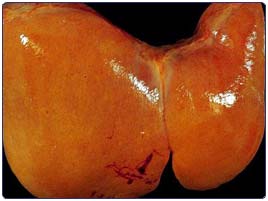Starchy Diet ‘May Damage Liver’
By BBC News | Sep 22, 2007

A diet rich in potatoes, white bread and white rice may be contributing to a “silent epidemic” of a dangerous liver condition.
“High-glycaemic” foods – rapidly digested by the body – could be causing “fatty liver”, increasing the risk of serious illness.
Boston-based researchers, writing in the journal Obesity, found mice fed starchy foods developed the disease.
Those fed a similar quantity of other foods did not.
One obesity expert said fatty liver in today’s children was “a tragedy of the future”.
Fatty liver is exactly as it sounds – a build-up over time of fat deposits around the organ.
At the time, no ill-effects are felt, but it has been linked with a higher risk of potentially fatal liver failure later in life.
The study, carried out at Boston Children’s Hospital, looked at the effect of diets with precisely the same calorific content, but very different ingredients when measured using the glycaemic index (GI).
This is a measure of how quickly the energy in the food is absorbed by the body, producing a rise in blood sugar levels – high GI foods lead to sharper rises in blood sugar, and similar rises in insulin levels, as the body releases the chemical in response.
High GI foods include many breakfast cereals and processed foods such as white bread and white rice.
Low GI foods include unprocessed fruit, nuts, pulses and grains, including rye or granary bread, spaghetti, apples and oranges.
Silent and deadly
After six months on the diet, the mice weighed the same, but those on the high GI diet had twice the normal amount of fat in their bodies, blood and livers.
The researchers say that because the processed carbohydrates are absorbed so quickly, they trigger the release of more of the chemical insulin, which tells the body to lay down more fat.
Dr David Ludwig, who led the research, said that the results would also apply to humans, and even children, in whom fatty liver is becoming far more common.
Between a quarter and half of all overweight American children are thought to have the condition, he said.
“This is a silent but dangerous epidemic,” he said.
“Just as type 2 diabetes exploded into our consciousness in the 1990s, so we think fatty liver will in the coming decade.”
Insulin resistance
Tam Fry, National Obesity Forum board member and chairman of the Child Growth Foundation, said it was clear that eating a diet rich in high-glycaemic food led to increased fat.
He said: “Fatty liver is going to be one of the tragedies of the future unless we do something about it.”
Azmina Govindja, a dietician and spokesman for the British Dietetic Association, said that the biggest threat from a diet rich in high-glycaemic food was development of insulin resistance – the first sign of type 2 diabetes.
She said: “There is a place for high-glycaemic carbohydrates in moderation as part of a balanced diet, but there’s good research that eating too much can increase the risk of insulin resistance – and this can lead to serious health problems.
“However, this study is interesting, as there is other evidence that people who eat a diet rich in high-glycaemic food are more likely to have more body fat.”















